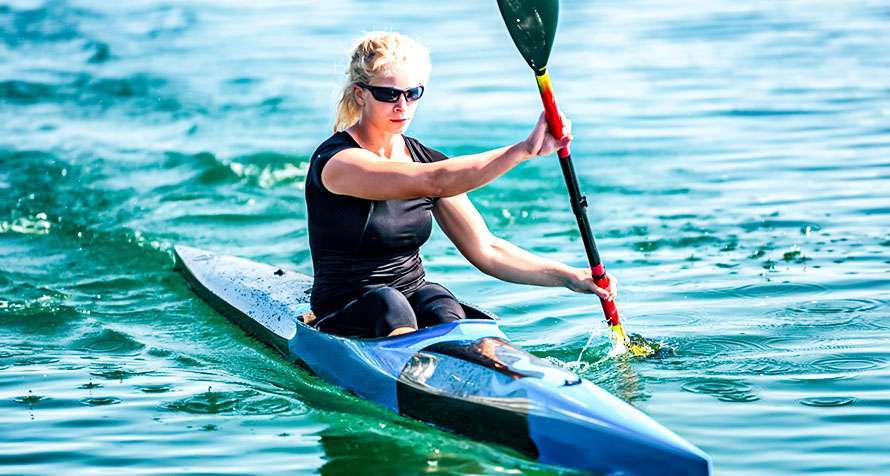The most basic of playboating moves is the front surf. It’s essential to all playboating; the better you are at it, the easier it is to do other moves. Even if you’re comfortable surfing waves, the techniques here will increase your success rate and improve your rides. Each wave is different, varying in speed, volume, steepness and accessibility. Wave surfing revolves around putting your boat on the wave in control and adjusting for these factors.
Catching a wave from an eddy
Getting on a wave is simply a ferry from an eddy to the wave. The goal is to ferry onto the sweet spot where your boat can be in equilibrium, where gravity and oncoming water are balanced. This spot is not in the trough but somewhere on the face. It is essential to have a good ferry in which you are in control of your angle and boat position from the time you cross the eddyline until you are established on the wave.
Tips:
- Start low enough in the eddy and below the wave to get some speed to cross the eddyline.
- Spot your target (turn your head and look at the sweet spot on the wave).
- Ferry to that sweet spot using proper peel out and ferry technique.
Pull yourself across the eddyline with a forward stroke into an open-faced stern draw until you get to the sweet spot.
For most waves, the sweet spot is where the wave is the largest and steepest. For particularly steep waves, the sweet spot can be found where it isn’t so steep. Your goal is to read the water so you know what the sweet spot looks like. As your skills increase, you will be able to surf more of the wave, with the sweet spot becoming a safety net.
Common mistakes made getting onto a wave
- Peeling out above the wave and dropping back into it. This puts you at the mercy of the wave, is more physically demanding, and puts you blindly onto the wave. The only time to enter a wave from above is when it is not possible to enter from the side.
- Not keeping eyes fixed on target. Most people who have trouble catching waves have their eyes fixed straight over the bow, and only see the oncoming water and their bow, resulting in disorientation. This causes them to lose their bow downstream, or peel out of the eddy too high or too low. It’s easier to hit a target you are aiming for if you are looking at it ahead of time.
- Improper strokes exiting the eddy. Take a forward stroke on the downstream side to pull your butt across the eddyline. Convert it into a stern draw to control the ferry out to the wave. Don’t try to rudder onto the wave from the eddyline.
Catching a wave from above
Step one is to get in front of the sweet spot (the steepest and largest part of the wave). Keep your boat sideways enough to see the sweetspot as you float toward it and make adjustments to insure you hit it. As soon as you get about four seconds from the wave, turn your boat upstream and take some medium-hard strokes. As you feel yourself dropping into the trough, paddle almost full speed, and as you feel yourself rising up the face, sprint all out. You should be able to stop your downstream momentum and catch the wave. Most people sprint too early. Timing is everything. Sprint when you are in the trough and rising up the face. Keep your body weight forward until you are surfing back upstream on the wave.
Surfing Around on a Wave
For the most part, surfing occurs on waves that don’t have a large surfable area. Any direction you move will eventually lead you off the wave. When entering a wave, keep your eyes on the sweet spot. Your goal is to put your butt on top of it. If you notice you are moving downstream of the sweetspot paddle harder. If you are moving forward of it, slow down.
The smaller the wave, the more difficult it is to stay on it. Once you are on the sweetspot, you must go somewhere else immediately (unless you’re paddling a boat that won’t pearl or the wave is big enough to let you sit there.) There are several places you can go: left, right, up, down, or backwards. When you turn left or right, you will be lifted up to the top of the wave. When you surf straight on, you will drop down into the trough. Planing hull boats are more forgiving for surfing because you don’t have to worry about overturning. If you turn too much they slide sideways and stay on the wave instead of peeling off.
Types of front surfing
Parking: dropping into the trough and sitting there. You have probably done this before. It is very satisfying because you don’t have to do anything except enjoy the rush of water. To do this you need a boat that will blast a wave, the more rocker the better. Ferry out to the sweet spot and let yourself drop into the trough, then lean back and enjoy equilibrium, your boat will automatically settle in the trough. Use small rudder strokes on either side to keep the boat straight.
Cutting
Surfing back and forth
There are varying degrees of cutting (mild, medium, or aggressive), each involving paddle, body and boat movements. Most boats will assist you in turning on a wave if you lean the boat in the direction you want to turn. Mild cutting: rudder left until boat is pointed left, and then rudder right before boat surfs off the side of the wave. Repeat as desired.
Medium cutting
Rudder harder so the boat would surf off the wave unless you rudder it back the other way immediately. A forward stroke may be needed after each rudder to stay on wave. Aggressive cutting: rudder as hard as possible, followed by a forward stroke on the same side to keep you on the wave and bring you back across the face (the same as medium cutting with more emphasis on speed and staying near the peak).
Proper body positions and movements –
Mild cutting
Keep your weight back to prevent the bow from pearling on smaller waves; on larger waves keep your weight neutral. Medium cutting: keep body neutral except when using a rudder. Lean forward when using your rudder (the same position as a reverse sweep, parallel to the boat, back at the stern). Turn your boat to the side by prying the stern away from the paddle. The more aggressive your turning strokes, the higher you’ll pull yourself up on the wave and the more likely you’ll need forward strokes to keep you on the wave. The best combination is to rudder on one side and then take a forward stroke on the same side.
Aggressive cutting
Your body moves forward to neutral and back with precise timing to make the boat respond quickly. Stay neutral until your boat turns past the direction of the oncoming water, then throw your weight forward to get the bow down so it will accelerate you the other way. Once you put in a forward stroke, sit upright until you begin to turn back again. The goal is to keep the boat ends out of the water by keeping your body neutral. Once you have made most of your turn, drop the bow for forward speed.
Proper boat positions for cutting –
Mild cutting
keep your boat nearly flat and near the trough. Lean the downstream edge in the water only enough to keep you from catching the upstream edge and pearling. Medium cutting: same as mild cutting with more downstream lean which rides you up the face more and increases speed. Transfer from one edge to the other just as you cut the other way.
Aggressive cutting
Throw your boat with all your strength. Start in a normal surf and then rudder your boat to 45 degrees, letting your boat rise to the top of the wave. Keep the downstream edge in the water until you are ready to cut the other way. As soon as you begin your rudder and throw your weight back to neutral, switch to an upstream lean and begin to drop the bow down (your bow should be in the air). Your goal is to get the bow down into the water and the downstream edge in as soon as possible. The faster the transition from surfing one way to cutting back and dropping the bow to surf the other way the better.
Remember that the bigger and faster the wave, the more possibilities it presents. However, any wave is a good place to practice the techniques described here. Take this information out to the river and see what you can do with it.
Last modified: March 14, 2022


